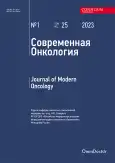Characteristics of the receptor phenotype of tumor-associated immune cells of the epithelial-mesenchymal microenvironment of ovarian cancer
- 作者: Zhurman V.N.1,2
-
隶属关系:
- Primorsky Regional Oncological Dispensary
- Pacific State Medical Univercity
- 期: 卷 25, 编号 1 (2023)
- 页面: 99-103
- 栏目: CLINICAL ONCOLOGY
- URL: https://journals.rcsi.science/1815-1434/article/view/132801
- DOI: https://doi.org/10.26442/18151434.2023.1.202076
- ID: 132801
如何引用文章
全文:
详细
Among all histological types, serous carcinomas account for up to 85%. Due to pronounced heterogeneity (at the molecular and genetic level) and chemoresistance, difficulties arise in finding active targets for tumor elimination.
Aim. To establish a link between the population composition of tumor-associated immune cells of the microenvironment and the stage of serous ovarian cancer.
Materials and methods. The analysis of the pathologic and anatomical material in 74 patients with serous ovarian cancer was carried out. Monoclonal antibodies were used to determine antigens in the samples: CD3, CD4, CD8, CD11b, CD14 and CD16.
Results. The obtained results of the immunohistochemical study showed that in the composition of the immune cells of the microenvironment, the largest number of cells, at all stages (I–IV) of the oncological process, are represented by macrophages (CD11b+, CD14+), CD3+ lymphocytes are in second place in terms of the number of cells, followed by CD8+ and CD4+ and the smallest number of CD16+ cells.
Conclusion. As a result of the immunohistochemical study, a multidirectional trend was found between the population composition of tumor-associated immune cells of the microenvironment and the stage of serous ovarian cancer. With an increase in the stage of the disease, the number of macrophages (CD11b+, CD14+) and lymphocytes (CD3+, CD16+) decreased regardless of the degree of differentiation of the tumor. With an increase in the tumor stage, the number of CD4+ and CD8+ populations decreased, but in this case, the degree of differentiation played a significant role, i.e. the higher the tumor stage and the lower the degree of differentiation, the fewer cells were detected.
作者简介
Varvara Zhurman
Primorsky Regional Oncological Dispensary; Pacific State Medical Univercity
编辑信件的主要联系方式.
Email: varvara2007@yandex.ru
ORCID iD: 0000-0002-6927-3336
Cand. Sci. (Med.), Primorsky Regional Oncological Dispensary, Pacific State Medical Univercity
俄罗斯联邦, Vladivostok参考
- Ефимова О.А., Сафонова М.А. Эпидемиология рака яичников на ранних стадиях. Клиническая и профилактическая медицина. 2018;4:9-18 [Efimova OA, Safonova MA. Epidemiologiia raka iaichnikov na rannikh stadiiakh. Klinicheskaia i profilakticheskaia meditsina. 2018;4:9-18 (in Russian)].
- Давыдова И.Ю., Кузнецов В.В., Карселадзе А.И. Серозные пограничные опухоли яичников (клиническое течение, морфология, лечение). Опухоли женской репродуктивной системы. 2012;3-4:165-8 [Davydova IYu, Kuznetsov VV, Karseladze AI. Serous borderline ovarian tumors (clinical features, morphology, treatment). Tumors of female reproductive system. 2012;3-4:165-8 (in Russian)]. doi: 10.17650/1994-4098-2012-0-3-4-165-168
- Солопова А.Е., Чащин А.А., Солопова А.Г., Макацария А.Д. Современные взгляды на патогенез и возможности диагностики эпителиального рака яичников. Акушерство, Гинекология и Репродукция. 2016;10(1):75-83 [Solopova AE, Chashchin AA, Solopova AG, Makatsariya AD. Current opinions concerning the pathogenesis of epithelial ovarian cancer and new diagnostic approaches to the disease. Obstetrics, Gynecology and Reproduction. 2016;10(1):75-83 (in Russian)]. doi: 10.17749/2313-7347.2015.10.1.075-083
- Солопова А.Е., Чащин А.А., Солопова А.Г., Макацария А.Д. Эпителиальный рак яичников. Клиническая лекция. Акушерство, Гинекология и Репродукция. 2016;10(3):53-65 [Solopova AE, Chashchin AA, Solopova AG, Makatsariya AD. Epithelial ovarian cancer. clinical lecture. Obstetrics, Gynecology and Reproduction. 2016;10(3):53-65 (in Russian)].
- Халикова Л.В. Количественное гистологическое исследование реакции иммунной системы на рак яичников и его прогностическое значение Креативная хирургия и онкология. 2014;4:49-52 [Khalikova LV. Quantitative histological study of the immune response for ovarian cancer and its prognostic significance. Creative Surgery and Oncology. 2014;4:49-52 (in Russian)]. doi: 10.24060/2076-3093-2014-0-4-49-52
- Roma-Rodrigues C, Mendes R, Baptista PV, Fernandes AR. Targeting Tumor Microenvironment for Cancer Therapy. Int J Mol Sci. 2019;20(4):840. doi: 10.3390/ijms20040840
- Hinshaw DC, Shevde LA. The Tumor Microenvironment Innately Modulates Cancer Progression. Cancer Res. 2019;79(18):45574566. doi: 10.1158/0008-5472.CAN-18-3962
- Mhawech-Fauceglia P, Wang D, Ali L, et al. Intraepithelial T cells and tumor-associated macrophages in ovarian cancer patients. Cancer Immun. 2013;13:1.
- Vitale I, Manic G, Coussens LM, et al. Macrophages and Metabolism in the Tumor Microenvironment. Cell Metab. 2019;30(1):36-50. doi: 10.1016/j.cmet.2019.06.001
- Богданова И.М., Болтовская М.Н., Рахмилевич А.Л., Артемьева К.A. Ключевая роль опухоль-ассоциированных макрофагов в прогрессировании и метастазировании опухолей. Иммунология. 2019;40(4):41-7 [Bogdanova IM, Boltovskaya MN, Rakhmilevich AL, Artemyeva KA. Key role of tumor-associated macrophages in the progression and metastasis of tumors. Immunologiya. 2019;40(4):41-7 (in Russian)]. doi: 10.24411/0206-4952-2019-14005
- Zhou K, Cheng T, Zhan J, et al. Targeting tumor-associated macrophages in the tumor microenvironment. Oncol Lett. 2020;20(5):234. doi: 10.3892/ol.2020.12097
- Златник Е.Ю., Неродо Г.А., Арджа А.Ю., и др. Роль иммунологической памяти в формировании противоопухолевого иммунитета у больных раком яичников на этапе неоадъювантного лечения. Вестник РГМУ. 2017;5:63-73 [Zlatnik EY, Nerodo GA, Ardzha AY, et al. The role of immunological memory in establishing antitumor immunity in patients with ovarian cancer undergoing neoadjuvant therapy. Bulletin of RSMU. 2017;5:63-73 (in Russian)]. doi: 10.24075/brsmu.2017-05-06
- Terrén I, Orrantia A, Joana Vitallé J, et al. NK Cell Metabolism and Tumor Microenvironment. Front Immunol. 2019;10:2278. doi: 10.3389/fimmu.2019.02278
- Коцюрбий Е.А., Тихонов Я.Н., Назарова И.В., и др. Практическое использование метода клеточных блоков для диагностики новообразований поджелудочной железы и опухолевых процессов других локализаций. Тихоокеанский медицинский журнал. 2020;4:90-2 [Kotsyrbiy EA, Tychonov YN, Nazarova IV, et al. Practical application of the cell block technique for the diagnostics of the tumors of the pancreas and of other localizations. Pacific Medical Journal. 2020;4:90-2 (in Russian)]. doi: 10.34215/1609-1175-2020-4-90-92
补充文件



















